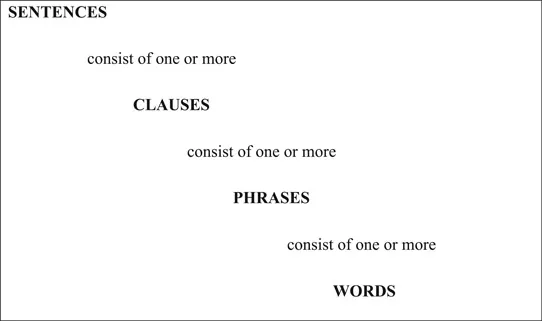
eBook - ePub
English: An Essential Grammar
Gerald Nelson
This is a test
Partager le livre
- 244 pages
- English
- ePUB (adapté aux mobiles)
- Disponible sur iOS et Android
eBook - ePub
English: An Essential Grammar
Gerald Nelson
Détails du livre
Aperçu du livre
Table des matières
Citations
À propos de ce livre
English: An Essential Grammar is written specifically for native speakers, beginning with the basics and going on to deal with phrase, clause and sentence structure, word formation and spelling. This fully revised third edition features new material on:
-
- the structure of phrases and clauses
-
- light verbs
-
- nominal adjectives
-
- the Operator
-
- preposition to and infinitival to
-
- the four that s
-
- determiners, prepositions, and common errors
With new exercises and answers for all new sections, this Essential Grammar continues to be the ideal reference for anyone who would like to improve their knowledge of English grammar.
Foire aux questions
Comment puis-je résilier mon abonnement ?
Il vous suffit de vous rendre dans la section compte dans paramètres et de cliquer sur « Résilier l’abonnement ». C’est aussi simple que cela ! Une fois que vous aurez résilié votre abonnement, il restera actif pour le reste de la période pour laquelle vous avez payé. Découvrez-en plus ici.
Puis-je / comment puis-je télécharger des livres ?
Pour le moment, tous nos livres en format ePub adaptés aux mobiles peuvent être téléchargés via l’application. La plupart de nos PDF sont également disponibles en téléchargement et les autres seront téléchargeables très prochainement. Découvrez-en plus ici.
Quelle est la différence entre les formules tarifaires ?
Les deux abonnements vous donnent un accès complet à la bibliothèque et à toutes les fonctionnalités de Perlego. Les seules différences sont les tarifs ainsi que la période d’abonnement : avec l’abonnement annuel, vous économiserez environ 30 % par rapport à 12 mois d’abonnement mensuel.
Qu’est-ce que Perlego ?
Nous sommes un service d’abonnement à des ouvrages universitaires en ligne, où vous pouvez accéder à toute une bibliothèque pour un prix inférieur à celui d’un seul livre par mois. Avec plus d’un million de livres sur plus de 1 000 sujets, nous avons ce qu’il vous faut ! Découvrez-en plus ici.
Prenez-vous en charge la synthèse vocale ?
Recherchez le symbole Écouter sur votre prochain livre pour voir si vous pouvez l’écouter. L’outil Écouter lit le texte à haute voix pour vous, en surlignant le passage qui est en cours de lecture. Vous pouvez le mettre sur pause, l’accélérer ou le ralentir. Découvrez-en plus ici.
Est-ce que English: An Essential Grammar est un PDF/ePUB en ligne ?
Oui, vous pouvez accéder à English: An Essential Grammar par Gerald Nelson en format PDF et/ou ePUB ainsi qu’à d’autres livres populaires dans Languages & Linguistics et Languages. Nous disposons de plus d’un million d’ouvrages à découvrir dans notre catalogue.
Informations
Chapter 1
Introducing sentence structure
1.1 The constituents of a sentence
Consider the following sentence:
My father retired when he was sixty.
The sentence consists of seven words in a specific order. However, it is not simply a sequence of seven individual words. Instead, certain words ‘go together’ to form meaningful units, as follows:
[My father] [retired] [when he was sixty].
One of these units (retired) consists of just one word, while the others are multi-word combinations. Regardless of their length, however, these are the basic ‘building blocks’ of the sentence, and they are known in grammar as the constituents of the sentence. A constituent is a word or a string of words that behaves grammatically and semantically as a unit.
So our sentence consists of seven words but only three constituents. Each constituent has its own grammatical function: my father, for example, functions as the Subject (1.4) and when he was sixty functions as an Adjunct (1.8). Every constituent has a complete meaning in itself, and for that reason, every constituent (except the verb) can be replaced by a single word:
[My father] [retired] [when he was sixty]. → [He] [retired] [then].
Similarly:
[After the robbery], [the thieves] [drove] [to a safe house]. → [Then], [they] [drove] [there].
[The postman] [left] [the package] [on my doorstep]. → [He] [left] [it] [there].
[Paul] [married] [his girlfriend] [last August]. → [He] [married] [her] [then].
When you begin analysing the structure of a sentence, it is useful to apply this One-word Substitution Test, because it provides a useful initial overview of the sentence constituents.
1.2 The Grammatical Hierarchy
In grammar, there are only three types of constituents: words, phrases, and clauses. We will discuss words in Chapter 2, phrases in Chapter 3, and clauses in Chapter 4.
The Grammatical Hierarchy (Figure 1.1) provides a very useful summary of how these three types of constituents go together to form a sentence.
Words are at the bottom of the Hierarchy, and for many people, this is the most familiar area of grammar. Most people learn about word classes (nouns, verbs, adjectives, etc) early in their school careers, but do not continue their studies to look at how those words combine to form phrases and clauses. This is unfortunate, since the step from word level to phrase level is actually a very short one. For example, dog is a noun, but the dog, the little dog, and the little dog that I love are noun phrases (3.6). Similarly, happy is an adjective, while very happy and very happy to see you are adjective phrases (3.4).

Figure 1.1
The word-based approach to grammar – looking at word classes only – leads to a ver...